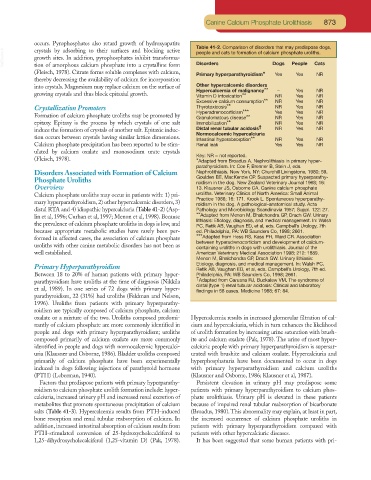Page 842 - Small Animal Clinical Nutrition 5th Edition
P. 842
Canine Calcium Phosphate Urolithiasis 873
occurs. Pyrophosphates also retard growth of hydroxyapatite
Table 41-2. Comparison of disorders that may predispose dogs,
VetBooks.ir growth sites. In addition, pyrophosphates inhibit transforma- people and cats to formation of calcium phosphate uroliths.
crystals by adsorbing to their surfaces and blocking active
Cats
People
Dogs
Disorders
tion of amorphous calcium phosphate into a crystalline form
(Fleisch, 1978). Citrate forms soluble complexes with calcium, Primary hyperparathyroidism* Yes Yes NR
thereby decreasing the availability of calcium for incorporation
into crystals. Magnesium may replace calcium on the surface of Other hypercalcemic disorders
Hypercalcemia of malignancy** – Yes NR
growing crystals and thus block epitaxial growth. Vitamin D intoxication** NR Yes NR
Excessive calcium consumption** NR Yes NR
Crystallization Promoters Thyrotoxicosis** NR Yes NR
Hyperadrenocorticism*** Yes Yes NR
Formation of calcium phosphate uroliths may be promoted by Granulomatous disease** NR Yes NR
epitaxy. Epitaxy is the process by which crystals of one salt Immobilization** † NR Yes NR
induce the formation of crystals of another salt. Epitaxic induc- Distal renal tubular acidosis NR Yes NR
Normocalcemic hypercalciuria
tion occurs between crystals having similar lattice dimensions. Intestinal hyperabsorption** NR Yes NR
Calcium phosphate precipitation has been reported to be stim- Renal leak Yes Yes NR
ulated by calcium oxalate and monosodium urate crystals
Key: NR = not reported.
(Fleisch, 1978). *Adapted from Broadus A. Nephrolithiasis in primary hyper-
parathyroidism. In: Coe F, Brenner B, Stein J, eds.
Disorders Associated with Formation of Calcium Nephrolithiasis. New York, NY: Churchill Livingstone, 1980; 59.
Phosphate Uroliths Goulden BE, MacKenzie CP. Suspected primary hyperparathy-
roidism in the dog. New Zealand Veterinary Journal 1968; 16:
Overview 13. Klausner JS, Osborne CA. Canine calcium phosphate
Calcium phosphate uroliths may occur in patients with: 1) pri- uroliths. Veterinary Clinics of North America: Small Animal
Practice 1986; 16: 171. Krook L. Spontaneous hyperparathy-
mary hyperparathyroidism, 2) other hypercalcemic disorders, 3) roidism in the dog. A pathological-anatomical study. Acta
distal RTA and 4) idiopathic hypercalciuria (Table 41-2) (Asp- Pathology and Microbiology Scandinavia 1957; Suppl. 122: 27.
lin et al, 1996; Curhan et al, 1997; Menon et al, 1998). Because **Adapted from Menon M, Bhalchondra GP, Drach GW. Urinary
lithiasis: Etiology, diagnosis, and medical management. In: Walsh
the prevalence of calcium phosphate uroliths in dogs is low, and PC, Retik AB, Vaughan ED, et al, eds. Campbell’s Urology, 7th
because appropriate metabolic studies have rarely been per- ed. Philadelphia, PA: WB Saunders Co, 1998; 2661.
formed in affected cases, the association of calcium phosphate ***Adapted from Hess RS, Kass PH, Ward CR. Association
between hyperadrenocorticism and development of calcium-
uroliths with other canine metabolic disorders has not been as containing uroliths in dogs with urolithiasis. Journal of the
well established. American Veterinary Medical Association 1998; 212: 1889.
Menon M, Bhalchondra GP, Drach GW. Urinary lithiasis:
Etiology, diagnosis, and medical management. In: Walsh PC,
Primary Hyperparathyroidism Retik AB, Vaughan ED, et al, eds. Campbell’s Urology, 7th ed.
Between 18 to 20% of human patients with primary hyper- Philadelphia, PA: WB Saunders Co, 1998; 2661.
†
parathyroidism have uroliths at the time of diagnosis (Nikkila Adapted from Caruana RJ, Buckalew VM. The syndrome of
distal (type 1) renal tubular acidosis: Clinical and laboratory
et al, 1989). In one series of 72 dogs with primary hyper- findings in 58 cases. Medicine 1988; 67: 84.
parathyroidism, 22 (31%) had uroliths (Feldman and Nelson,
1996). Uroliths from patients with primary hyperparathy-
roidism are typically composed of calcium phosphate, calcium
oxalate or a mixture of the two. Uroliths composed predomi- Hypercalcemia results in increased glomerular filtration of cal-
nantly of calcium phosphate are more commonly identified in cium and hypercalciuria, which in turn enhances the likelihood
people and dogs with primary hyperparathyroidism; uroliths of urolith formation by increasing urine saturation with brush-
composed primarily of calcium oxalate are more commonly ite and calcium oxalate (Pak, 1978). The urine of most hyper-
identified in people and dogs with normocalcemic hypercalci- calciuric people with primary hyperparathyroidism is supersat-
uria (Klausner and Osborne, 1986). Bladder uroliths composed urated with brushite and calcium oxalate. Hypercalciuria and
primarily of calcium phosphate have been experimentally hyperphosphaturia have been documented to occur in dogs
induced in dogs following injections of parathyroid hormone with primary hyperparathyroidism and calcium uroliths
(PTH) (Leberman, 1940). (Klausner and Osborne, 1986; Klausner et al, 1987).
Factors that predispose patients with primary hyperparathy- Persistent elevation in urinary pH may predispose some
roidism to calcium phosphate urolith formation include: hyper- patients with primary hyperparathyroidism to calcium phos-
calciuria, increased urinary pH and increased renal excretion of phate urolithiasis. Urinary pH is elevated in these patients
metabolites that promote spontaneous precipitation of calcium because of impaired renal tubular reabsorption of bicarbonate
salts (Table 41-3). Hypercalcemia results from PTH-induced (Broadus, 1980).This abnormality may explain, at least in part,
bone resorption and renal tubular reabsorption of calcium. In the increased occurrence of calcium phosphate uroliths in
addition, increased intestinal absorption of calcium results from patients with primary hyperparathyroidism compared with
PTH-stimulated conversion of 25-hydroxycholecalciferol to patients with other hypercalciuric diseases.
1,25-dihydroxycholecalciferol (1,25-vitamin D) (Pak, 1978). It has been suggested that some human patients with pri-

